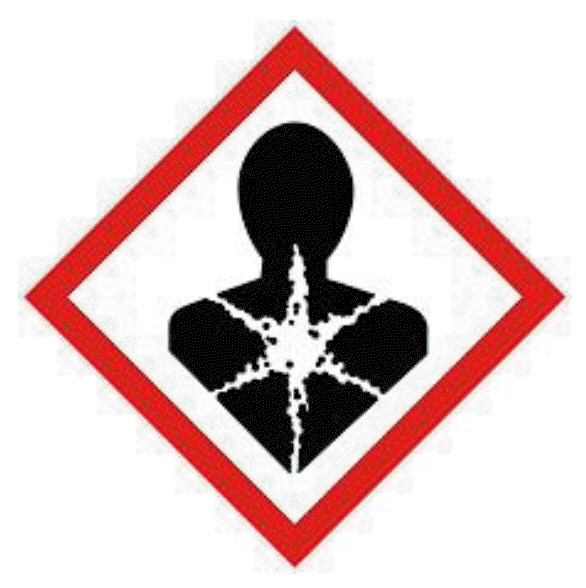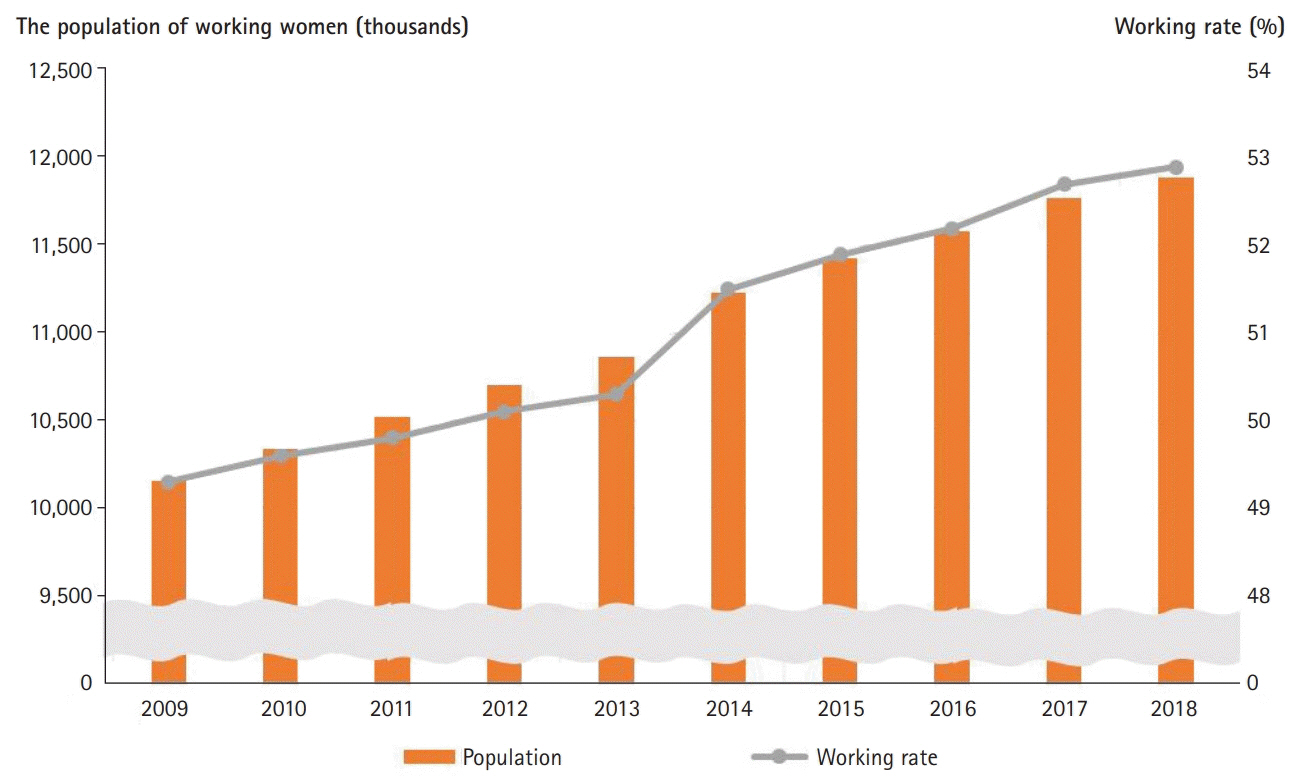Yeungnam Univ J Med.
2020 Jan;37(1):22-31. 10.12701/yujm.2019.00416.
Reproductive toxic agents in work environments and related cases in Korea
- Affiliations
-
- 1Department of Occupational and Environmental Medicine, Kang Mijung’s Internal Medicine Clinic, Daegu, Korea
- KMID: 2501404
- DOI: http://doi.org/10.12701/yujm.2019.00416
Abstract
- There has been a growing concern and subsequent interest surrounding numerous reproductive toxic agents found in various working and non-working environments. Meanwhile, there have been many efforts in medical fields such as toxicology and epidemiology applying experimental studies to elucidate reproductive toxic agents’ characterization and health effects. However, there remains insufficient research data and inadequate evidence in humans. Adverse reproductive outcomes vary from transient, moderate health effects to severely detrimental consequences, such as permanent infertility or childhood cancer of one’s offspring. Furthermore, upon exposure to toxic agents, the latent period before reproductive health effects are observed is relatively short compared to other occupational diseases (e.g., occupational cancer); instant action is required once exposure to reproductive toxic agents is detected. Therefore, it is very important for workers and healthcare professionals to know about the reproductive toxic agents they are likely to be exposed to. In this review, we discuss the general epidemiology of reproductive health in Korea, and the information regarding these reproductive toxic agents.
Figure
Reference
-
References
1. Meyer JD, McDiarmid M, Diaz JH, Baker BA, Hieb M; ACOEM Task Force on Reproductive Toxicology. Reproductive and fevelopmental hazard management. J Occup Environ Med. 2016; 58:e94–102.2. Mattison DR, Thomford PJ. The mechanisms of action of reproductive toxicants. Toxicol Pathol. 1989; 17:364–76.
Article3. Rim KT. Reproductive Toxic chemicals at work and efforts to protect workers' health: a literature review. Saf Health Work. 2017; 8:143–50.
Article4. Statistics Korea. Final results of birth statistics in 2018 [Internet]. Daejeon, Korea: Statistics Korea;2019. [cited 2019 Dec 18]. http://kostat.go.kr/portal/eng/pressReleases/1/index.board?bmode=read&aSeq=378026.5. Health Insurance Review & Assessment Service. Healthcare Bigdata Hub Korea: statistics of national public data [Internet]. Wonju, Korea: Health Insurance Review & Assessment Service;2019. [cited 2019 Dec 18]. http://opendata.hira.or.kr/op/opc/olapMfrnIntrsIlnsInfo.do.6. Occupational Safety and Health Administration; United States Department of Labor. Hazard communication standard pictogram [Internet]. Occupational Safety and Health Administration;2015. [cited 2019 Dec 18]. https://www.osha.gov/Publications/HazComm_QuickCard_Pictogram.html.7. Lee S, Kim E. 2018 National survey of family health and welfare of Korea. Sejong, Korea: Korea Institute for Health and Social Affairs;2019.8. Wilcox AJ, Weinberg CR, O'Connor JF, Baird DD, Schlatterer JP, Canfield RE, et al. Incidence of early loss of pregnancy. N Engl J Med. 1988; 319:189–94.
Article9. Korean Statistical Information Service. Statistical database [Internet]. Daejeon, Korea: Statistic Korea;2019. [cited 2019 Dec 22]. http://kosis.kr/eng/.10. Park C, Kang MY, Kim D, Park J, Eom H, Kim EA. Prevalence of abortion and adverse pregnancy outcomes among working women in Korea: a cross-sectional study. PLoS One. 2017; 12:e0182341.
Article11. Korea Occupational Safety and Health Agency. Occupational safety & health guideline: workers using reproductive toxic agents [Internet]. Ulsan, Korea: Korea Occupational Safety and Health Agency;2017. [cited 2019 Dec 3]. http://kosha.or.kr/kosha/data/healthPromotionMediaData.do?mode=download&articleNo=241355&attachNo=118016.12. Korea Occupational Safety and Health Agency. Epidemiologic research on reproductive health in Korean workers (I) [Internet]. Ulsan, Korea: Korea Occupational Safety and Health Agency;2015. [cited 2019 Dec 3]. http://www.kosha.or.kr/kosha/researchField/researchReportSearch.do?mode=download&articleNo=63534&attachNo=57379.13. The National Institute for Occupational Safety and Health (NIOSH). NIOSH pocket guide to chemical hazards [Internet]. Washington, DC: NIOSH;2018. [cited 2019 Dec 3]. https://www.cdc.gov/niosh/npg/default.html.14. Institute for the Prevention of Occupational Accidents and Diseases (INRS). Demeter [Internet]. Paris: INRS;2017. [cited 2019 Dec 3]. http://www.inrs.fr/publications/bdd/demeter.html.15. Choi S, Kim I, Rim J, Kim W. A study on the review and improvement of regulations related to reproductive toxic chemicals. Ulsan, Korea: Korea Occupational Safety & Health Research Institute;2017.16. Mikhael S, Punjala-Patel A, Gavrilova-Jordan L. Hypothalamic-pituitary-ovarian axis disorders impacting female fertility. Biomedicines. 2019; 7:5.
Article17. Gracia CR, Sammel MD, Chittams J, Hummel AC, Shaunik A, Barnhart KT. Risk factors for spontaneous abortion in early symptomatic first-trimester pregnancies. Obstet Gynecol. 2005; 106:993–9.
Article18. Weiss JL, Malone FD, Vidaver J, Ball RH, Nyberg DA, Comstock CH, et al. Threatened abortion: a risk factor for poor pregnancy outcome, a population-based screening study. Am J Obstet Gynecol. 2004; 190:745–50.
Article19. Kugel G, Letelier C, Zive MA, King JC. Nitrous oxide and infertility. Anesth Prog. 1990; 37:176–80.20. Duong A, Steinmaus C, McHale CM, Vaughan CP, Zhang L. Reproductive and developmental toxicity of formaldehyde: a systematic review. Mutat Res. 2011; 728:118–38.
Article21. Plenge-Bonig A, Karmaus W. Exposure to toluene in the printing industry is associated with subfecundity in women but not in men. Occup Environ Med. 1999; 56:443–8.
Article22. Kim Y, Jung K, Hwang T, Jung G, Kim H, Park J, et al. Hematopoietic and reproductive hazards of Korean electronic workers exposed to solvents containing 2-bromopropane. Scand J Work Environ Health. 1996; 22:387–91.
Article23. Nurminen T. Shift work and reproductive health. Scand J Work Environ Health. 1998; 24:28–34.24. Selevan SG, Lindbohm ML, Hornung RW, Hemminki K. A study of occupational exposure to antineoplastic drugs and fetal loss in nurses. N Engl J Med. 1985; 313:1173–8.
Article25. Rowland AS, Baird DD, Shore DL, Darden B, Wilcox AJ. Ethylene oxide exposure may increase the risk of spontaneous abortion, preterm birth, and postterm birth. Epidemiology. 1996; 7:363–8.
Article26. Graeve CU, McGovern PM, Alexander B, Church T, Ryan A, Polovich M. Occupational exposure to antineoplastic agents. Workplace Health Saf. 2017; 65:9–20.
Article27. Hammer PEC, Garde AH, Begtrup LM, Flachs EM, Hansen J, Hansen AM, et al. Night work and sick leave during pregnancy: a national register-based within-worker cohort study. Occup Environ Med. 2019; 76:163–8.
Article28. Cordier S, Garlantezec R, Labat L, Rouget F, Monfort C, Bonvallot N, et al. Exposure during pregnancy to glycol ethers and chlorinated solvents and the risk of congenital malformations. Epidemiology. 2012; 23:806–12.
Article29. Huel G, Mergler D, Bowler R. Evidence for adverse reproductive outcomes among women microelectronic assembly workers. Br J Ind Med. 1990; 47:400–4.
Article30. Chen PH, Wong CK, Rappe C, Nygren M. Polychlorinated biphenyls, dibenzofurans and quaterphenyls in toxic rice-bran oil and in the blood and tissues of patients with PCB poisoning (Yu-Cheng) in Taiwan. Environ Health Perspect. 1985; 59:59–65.
Article31. Aoki Y. Polychlorinated biphenyls, polychlorinated dibenzo-p-dioxins, and polychlorinated dibenzofurans as endocrine disrupters--what we have learned from Yusho disease. Environ Res. 2001; 86:2–11.
Article32. MacDonald LA, Waters TR, Napolitano PG, Goddard DE, Ryan MA, Nielsen P, et al. Clinical guidelines for occupational lifting in pregnancy: evidence summary and provisional recommendations. Am J Obstet Gynecol. 2013; 209:80–8.
Article33. Neugebauer R, Kline J, Stein Z, Shrout P, Warburton D, Susser M. Association of stressful life events with chromosomally normal spontaneous abortion. Am J Epidemiol. 1996; 143:588–96.
Article34. LaDou J, Harrison R. Current occupational & environmental medicine. 5th ed. New York: McGraw-Hill education/Medical;2014.35. Loch-Caruso R, Trosko JE, Corcos IA. Interruption of cell-cell communication in Chinese hamster V79 cells by various alkyl glycol ethers: implications for teratogenicity. Environ Health Perspect. 1984; 57:119–23.
Article36. Levin AA, Plautz JR, di Sant'Agnese PA, Miller RK. Cadmium: placental mechanisms of fetal toxicity. Placenta Suppl. 1981; 3:303–18.37. Weizsaecker K. Lead toxicity during pregnancy. Prim Care Update Ob Gyns. 2003; 10:304–9.
Article38. Bose-O'Reilly S, McCarty KM, Steckling N, Lettmeier B. Mercury exposure and children's health. Curr Probl Pediatr Adolesc Health Care. 2010; 40:186–215.39. Koos BJ, Longo LD. Mercury toxicity in the pregnant woman, fetus, and newborn infant: a review. Am J Obstet Gynecol. 1976; 126:390–409.40. Mattison DR. The mechanisms of action of reproductive toxins. Am J Ind Med. 1983; 4:65–79.
Article41. Pizent A, Tariba B, Zivkovic T. Reproductive toxicity of metals in men. Arh Hig Rada Toksikol. 2012; 63:35–46.
Article42. Harris ID, Fronczak C, Roth L, Meacham RB. Fertility and the aging male. Rev Urol. 2011; 13:e184–90.43. Mocarelli P, Gerthoux PM, Needham LL, Patterson DG Jr, Limonta G, Falbo R, et al. Perinatal exposure to low doses of dioxin can permanently impair human semen quality. Environ Health Perspect. 2011; 119:713–8.
Article44. The National Institute for Occupational Safety and Health (NIOSH). The effects of workplace hazards on male reproductive health [Internet]. Washington, DC: NIOSH;2014. [cited 2019 Dec 3]. https://www.cdc.gov/niosh/docs/96-132/default.html.45. Whorton MD, Foliart DE. Mutagenicity, carcinogenicity and reproductive effects of dibromochloropropane (DBCP). Mutat Res. 1983; 123:13–30.
Article46. Easley CA 4th, Bradner JM, Moser A, Rickman CA, McEachin ZT, Merritt MM, et al. Assessing reproductive toxicity of two environmental toxicants with a novel in vitro human spermatogenic model. Stem Cell Res. 2015; 14:347–55.
Article47. Slutsky M, Levin JL, Levy BS. Azoospermia and oligospermia among a large cohort of DBCP applicators in 12 countries. Int J Occup Environ Health. 1999; 5:116–22.
Article48. Hosni H, Selim O, Abbas M, Fathy A. Semen quality and reproductive endocrinal function related to blood lead levels in infertile painters. Andrologia. 2013; 45:120–7.
Article49. Krstev S, Knutsson A. Occupational risk factors for prostate cancer: a meta-analysis. J Cancer Prev. 2019; 24:91–111.
Article50. Sidorkiewicz I, Zareba K, Wolczynski S, Czerniecki J. Endocrine-disrupting chemicals-Mechanisms of action on male reproductive system. Toxicol Ind Health. 2017; 33:601–9.
Article51. Cannon SB, Veazey JM Jr, Jackson RS, Burse VW, Hayes C, Straub WE, et al. Epidemic kepone poisoning in chemical workers. Am J Epidemiol. 1978; 107:529–37.
Article52. Park JS, Kim Y, Park DW, Choi KS, Park SH, Moon YH. An outbreak of hematopoietic and reproductive disorders due to solvents containing 2-bromopropane in an electronic factory, South Korea: epidemiological survey. J Occup Health. 1997; 39:138–43.
Article53. Korea Occupational Safety and Health Agency. Case reports of occupational diseases [Internet]. Ulsan, Korea: Korea Occupational Safety and Health Agency;2014. [cited 2019 Dec 3]. http://www.kosha.or.kr/kosha/data/occupationalDisease.do?mode=view&articleNo=348677&article.offset=290&articleLimit=10.54. Gilboa SM, Desrosiers TA, Lawson C, Lupo PJ, Riehle-Colarusso TJ, Stewart PA, et al. Association between maternal occupational exposure to organic solvents and congenital heart defects, National Birth Defects Prevention Study, 1997-2002. Occup Environ Med. 2012; 69:628–35.
Article55. Park J, Lee S, Park C, Eom H. A case of azoospermia in a non-destructive testing worker exposed to radiation. Ann Occup Environ Med. 2017; 29:33.56. Frazier LM, Jones TL. Managing patients with concerns about workplace reproductive hazards. J Am Med Womens Assoc (1972). 2000; 55:80–3.57. Grajewski B, Rocheleau CM, Lawson CC, Johnson CY. "Will my work affect my pregnancy?" Resources for anticipating and answering patients' questions. Am J Obstet Gynecol. 2016; 214:597–602.
Article
- Full Text Links
- Actions
-
Cited
- CITED
-
- Close
- Share
- Similar articles
-
- Health Inequalities Among Korean Employees
- Reproductive Toxic Chemicals at Work and Efforts to Protect Workers' Health: A Literature Review
- Lived Experiences toward Harmful Work Environment among Clinical Nurses: Phenomenological Approach
- Comparison of Patient-Sitter Ward Nurses and General Ward Nurses on Work-Related Musculoskeletal Symptoms, Occupational Stress and Nursing Work Environments
- Occupational Exposure to Physical and Chemical Risk Factors: A Systematic Review of Reproductive Pathophysiological Effects in Women and Men



